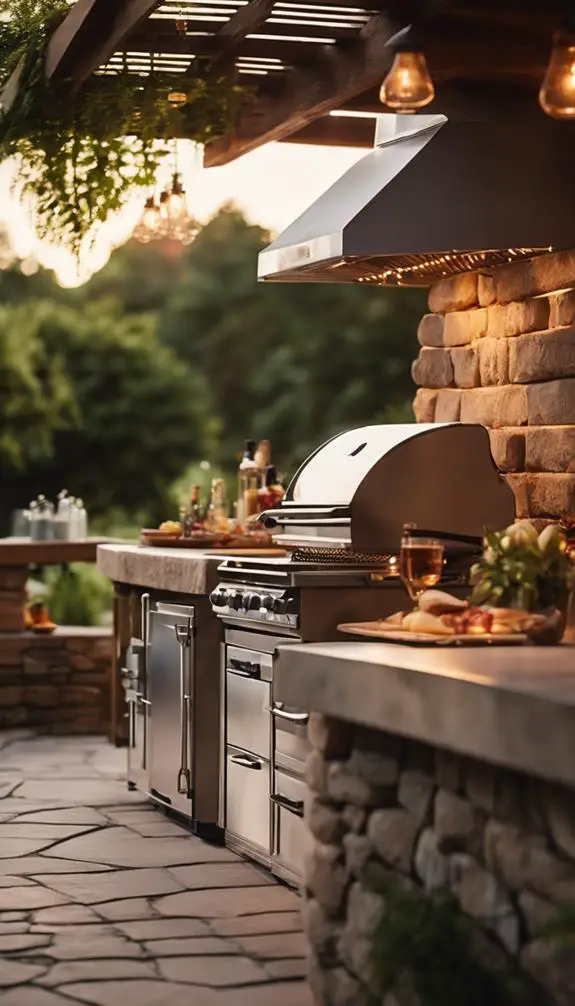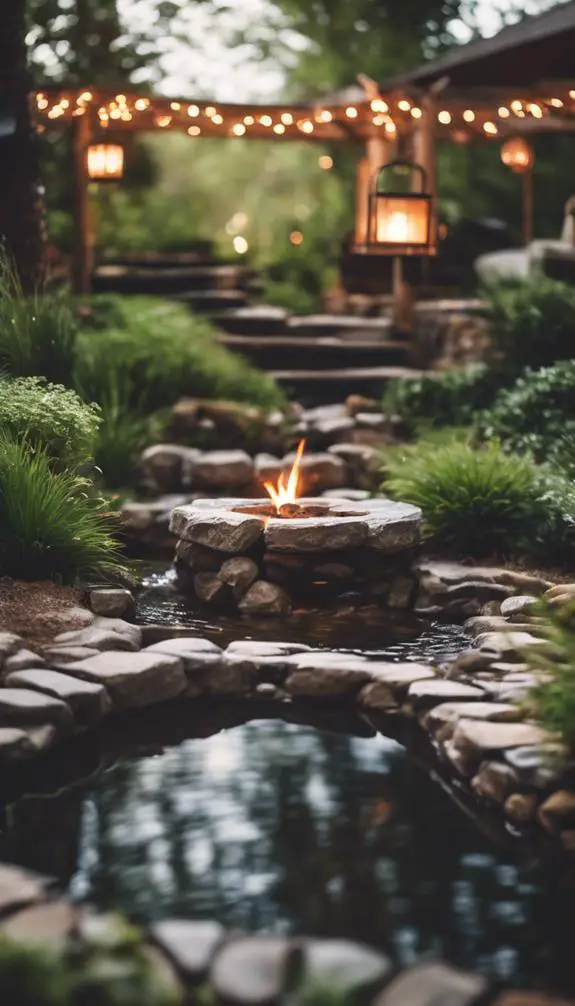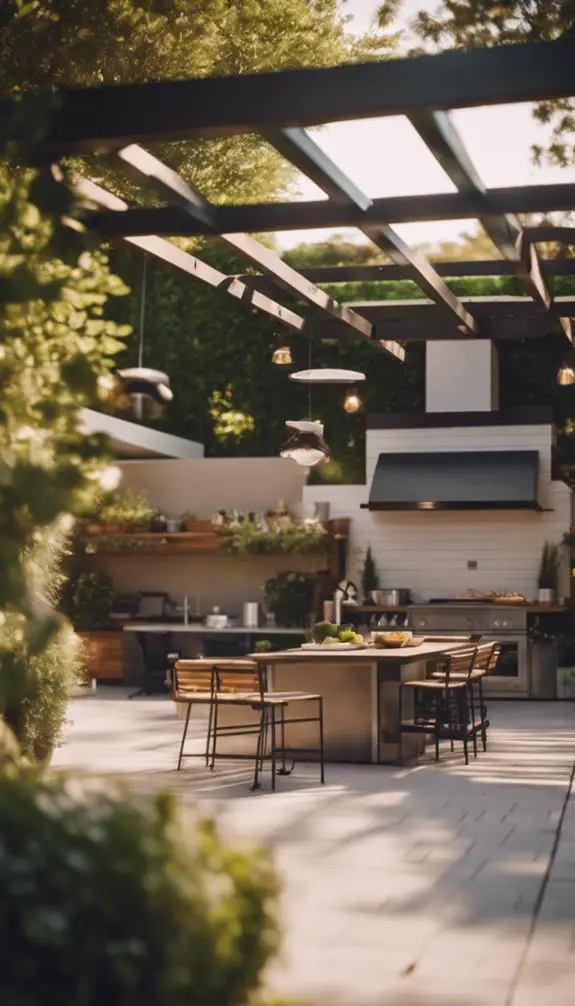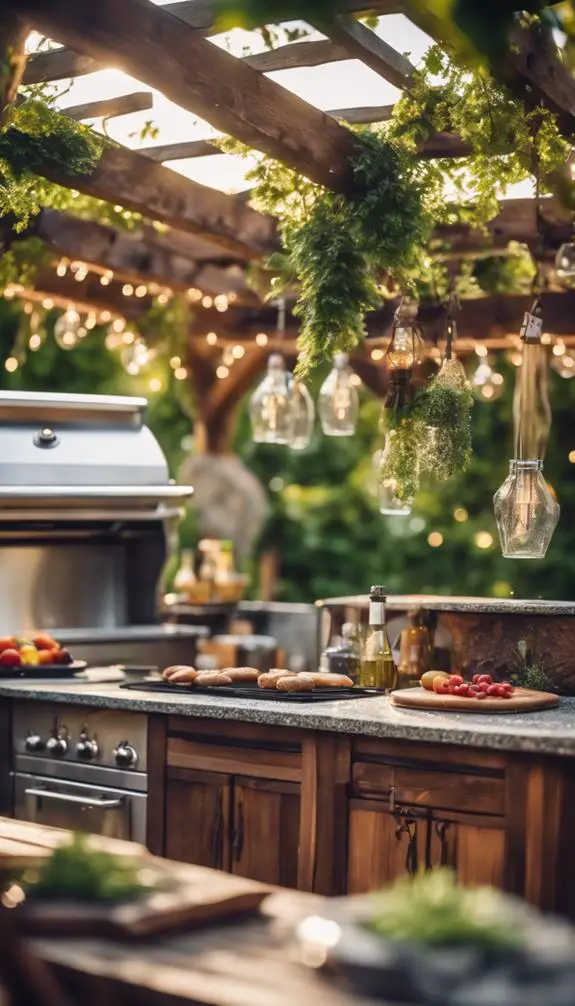As you step into your backyard, you envision a space where memories are made, and meals are savored. You're not alone in wanting to create an outdoor oasis that brings people together. A well-designed backyard kitchen can make all the difference, but where do you start? From grilling stations to outdoor bars, the possibilities are endless. You're likely wondering how to balance functionality with aesthetics, and which features will make the biggest impact. Let's explore the essential elements that'll transform your outdoor space into a warm and inviting haven that's perfect for year-round entertaining.
Summary
- Strategically placed countertops and utensil holders create a functional outdoor kitchen layout, perfect for prep work and plating.
- Grill stations with multiple cooking surfaces and ceramic tiles offer durability, versatility, and easy maintenance.
- Adequate storage and organization solutions, like cabinet systems and drawer organizers, maintain a clutter-free environment.
- Outdoor lighting, including string lights and lanterns, creates a warm ambiance, extending the entertainment area into the night.
- A cohesive patio design, incorporating durable flooring and native plants, harmonizes with the home's architecture and surrounding landscape.
Grilling Stations and BBQ Areas

Across from the patio, a grilling station or BBQ area beckons, drawing you in with the promise of sizzling burgers and savory aromas.
As you approach, notice the strategically placed countertops, providing ample space for prep work and plating.
To elevate your grill master tips, consider incorporating a built-in utensil holder and cutting board. These thoughtful details enhance the outdoor ambiance, making the space feel more like an extension of your indoor kitchen.
To take it to the next level, add a few outdoor heaters or a fire pit, allowing you to enjoy the space year-round.
Outdoor Cooking Surfaces

You'll need to ponder the essentials for your grill station, including the type and size of grill, as well as accompanying features like burners, sinks, and refrigeration.
The cooking surface material you choose will impact durability, maintenance, and overall performance, with options ranging from stainless steel to ceramic to natural stone.
As you design your outdoor countertops, think about the flow of your kitchen, incorporating elements like built-in cutting boards, utensil storage, and ample counter space.
Grill Station Essentials
When designing your outdoor kitchen, a grill station with multiple cooking surfaces is key to efficient meal prep and versatility.
To maximize functionality, consider a Grill Top Design that incorporates different zones for various cooking methods.
A Grill Zone Layout with separate areas for grilling, smoking, and cooking can help you multitask and prepare complex meals.
This setup allows you to simultaneously sear steaks, roast vegetables, and cook sides, making outdoor entertaining a breeze.
Cooking Surface Materials
With your grill station's zone layout in place, it's time to focus on the cooking surface materials that will bring your outdoor kitchen to life.
You'll need a surface that can withstand high temperatures, extreme weather conditions, and heavy use. Ceramic tiles are an excellent choice, offering a heat-resistant, durable, and easy-to-clean solution.
They come in a variety of styles, from rustic to modern, allowing you to create a unique look that complements your outdoor kitchen. When selecting ceramic tiles, verify they're specifically designed for outdoor use and can withstand temperatures above 500°F. This will guarantee your cooking surface remains functional and safe for years to come.
Outdoor Countertops Designs
Functionality and aesthetics converge in outdoor countertops, the unsung heroes of your backyard kitchen.
You'll want to choose countertop materials that can withstand the elements while complementing your outdoor accents. Consider durable options like stainless steel, granite, or recycled glass that can resist heat, moisture, and scratches.
For a sleek look, pair your countertops with matching outdoor accents, such as metal or glass railings, to create a cohesive design.
To add visual interest, incorporate a mix of textures and colors, like pairing rough-hewn stone with smooth metal.
Prep and Serving Stations

You'll need dedicated spaces for food preparation and presentation to elevate your outdoor cooking experience.
Designate a food prep zone with countertops, sinks, and storage to streamline meal prep.
Consider incorporating an outdoor serving bar with built-in coolers, wine racks, or utensil holders to create a seamless shift from cooking to serving.
Food Prep Zones
As you envision your backyard kitchen, consider how food prep zones will play a starring role in its functionality.
These zones are vital for meal planning and food sanitation. Designate a specific area for food preparation, such as a countertop or island, and equip it with essential tools like sinks, refrigerators, and cooking stations.
Guarantee the zone is well-ventilated and has ample storage for ingredients and utensils. A well-designed food prep zone will streamline your cooking process, allowing you to efficiently prepare meals while maintaining a clean and sanitary environment.
Outdoor Serving Bars
While designing your backyard kitchen, consider incorporating outdoor serving bars that double as prep and serving stations, seamlessly bridging the gap between food preparation and presentation.
These multi-functional bars feature outdoor shelving for storing plates, utensils, and glassware, keeping everything within easy reach. You can also integrate wine storage into the design, perfect for chilling your favorite vintages.
A built-in sink and refrigerator can further enhance the functionality of your outdoor serving bar. With ample counter space, you'll have room to plate dishes, garnish cocktails, and engage with guests while they mingle.
Dining and Seating Options

Harmony is key when it comes to creating an inviting outdoor dining space, and the right seating options can make all the difference.
You'll want to choose outdoor tables that complement your backyard's unique aesthetic. Consider a sleek, modern design or a rustic, natural look, depending on your style.
Create cozy nooks by incorporating built-in benches or plush sectionals. Don't forget to add comfortable cushions and pillows in vibrant colors to tie the space together.
Outdoor Bars and Beverage Stations

When designing an outdoor bar, you'll want to ponder the essentials: a functional layout, adequate counter space, and sufficient storage for glasses, bottles, and garnishes.
A well-planned refreshment station should also incorporate a logical workflow, ensuring that you can easily move from prep to serving.
Bar Design Essentials
Your outdoor kitchen's bar design is more than just a gathering spot – it's a focal point where memories are made and conversations flow.
When designing your bar, consider the layout. A well-planned bar layout guarantees efficient traffic flow and comfortable seating. Opt for a curved or L-shaped design to create a sense of enclosure and encourage socializing.
To elevate the bar ambiance, incorporate lighting that sets the tone for your outdoor space. LED lights, lanterns, or string lights can create a warm and inviting atmosphere.
Add decorative elements, such as a statement backsplash or a unique countertop, to make your bar design truly unique. By balancing form and function, you'll create a bar that's both beautiful and functional.
Refreshment Station Layout
Beyond the social hub of your outdoor kitchen's bar, a well-designed refreshment station layout can elevate the entire outdoor dining experience.
Consider the Refreshment Flow: how will guests move through the space to grab a drink or snack? A clear pathway and strategically placed stations will keep the flow smooth.
Station Signage is key – use clear labels and signs to direct guests to the right spot. Think about the types of beverages and snacks you'll be serving and design the layout accordingly.
For example, if you'll be serving cocktails, consider a dedicated cocktail station with a built-in ice bin and garnish station. With a well-planned refreshment station layout, you'll create an efficient, enjoyable experience for your guests.
Kitchen Island and Cart Ideas

Across from the main cooking station, a kitchen island or cart can bridge the gap between food preparation and dining areas, providing a convenient spot to chop, season, and serve.
You'll appreciate the flexibility of a kitchen island or cart, as it can be easily moved to accommodate different kitchen layouts. Consider a cart with built-in utensil organizers and spice racks to maximize cart organization.
When designing your kitchen layout, think about the workflow and place the island or cart in a way that creates a seamless shift between cooking and serving. A well-placed island or cart can streamline your outdoor cooking experience, making it more efficient and enjoyable.
Storage and Organization Solutions

A well-designed outdoor kitchen relies heavily on strategic storage and organization solutions to maintain a clutter-free environment, ensuring you can focus on cooking and entertaining.
You'll want to incorporate cabinet systems that provide ample storage for utensils, seasonings, and cookware. Look for systems with adjustable shelves, drawers, and cabinets to maximize your outdoor kitchen's storage capacity.
To further optimize your space, consider installing drawer organizers with dividers and inserts to keep items like plates, glasses, and silverware neatly arranged. This thoughtful approach to storage and organization will create a seamless cooking experience, allowing you to effortlessly shift between prep, cook, and serve.
Lighting and Electrical Considerations

As you step into your outdoor kitchen, strategically placed lighting fixtures illuminate the space, creating an inviting ambiance that extends the entertainment area into the night.
To achieve this, you'll need to ponder voltage requirements for your lighting and appliances. Verify that your electrical infrastructure can support the load, and consult with a professional if necessary.
Effective cable management is also vital to maintain a clutter-free and safe outdoor kitchen. Use weather-resistant cables and conceal them in decorative cable channels or underground conduits. This won't only enhance the aesthetic but also protect your electrical components from the elements.
Flooring and Patio Design

Your outdoor kitchen's flooring and patio design set the stage for a seamless shift between indoor and outdoor living.
When selecting floor textures, consider durable, low-maintenance options like porcelain pavers, natural stone, or concrete. These materials can withstand heavy foot traffic and harsh weather conditions.
For a cohesive look, choose a patio style that complements your home's architecture and the surrounding landscape.
A modern, sleek patio style can be achieved with clean-lined furniture and geometric patterns, while a rustic, natural look can be created with organic materials and curved lines.
Confirm your flooring and patio design harmonize to create a functional, stylish outdoor space that flows effortlessly with your indoor kitchen.
Water Features and Fire Pits

Three essential elements can elevate your backyard kitchen from functional to fantastic: water features, fire pits, and outdoor lighting.
You can incorporate water accents, such as small ponds, fountains, or bubblers, to create a soothing atmosphere. These water features become focal points, drawing the eye and creating visual interest.
Fire pits, on the other hand, extend your outdoor living season, providing a cozy gathering spot on chilly evenings. Strategically placing them near seating areas or outdoor kitchens enhances their functionality.
Landscaping and Garden Integration

Beyond the kitchen's perimeter, landscaping and garden integration become essential in creating a seamless shift between indoor and outdoor spaces.
You'll want to incorporate native plants that thrive in your local climate, reducing maintenance and supporting local ecosystems. Consider vertical gardens, which maximize space and add visual interest.
These living walls can be integrated into your kitchen's design, blurring the lines between interior and exterior. By incorporating these elements, you'll create a cohesive and inviting outdoor space that complements your kitchen.
Think about how you can use lighting, texture, and color to tie everything together. With careful planning, your outdoor space will become an extension of your kitchen, perfect for entertaining and relaxing.
Budget-Friendly DIY Projects

As you've masterfully blended your kitchen with its surroundings, now it's time to focus on adding personal touches without breaking the bank.
One way to do this is by incorporating summer decor elements, such as colorful throw pillows, vibrant planters, and revitalizing outdoor rugs.
To elevate your space, consider DIY projects like upcycling old lanterns into unique backyard lighting fixtures or repurposing wooden crates into rustic shelving units.
You can also add ambiance with string lights or fairy lights, which are easy to install and budget-friendly.
By getting creative with DIY projects, you'll be able to add personality to your outdoor kitchen without sacrificing style or your wallet.
With a little imagination, you can transform your backyard into a warm and inviting oasis.
FAQs
How Do I Keep Outdoor Kitchen Appliances From Rusting?
You'll prevent rust on outdoor appliances by applying rust-inhibiting coatings, regularly cleaning with mild detergents, and drying thoroughly, while also storing them in a dry area or using covers when not in use, following these essential rust prevention methods and appliance maintenance tips.
Can I Use Indoor Kitchen Cabinets Outside?
You'll need cabinets with weather-resistant materials, like stainless steel, polymer, or fiberglass, to withstand outdoor conditions. Look for cabinets with durable finishes, seals, and drainage systems to guarantee moisture doesn't compromise their structure or functionality.
Do Outdoor Kitchens Increase Property Value?
You'll boost your property's appraisal impact and reap significant resale benefits by incorporating an outdoor kitchen, as it adds functional living space, increasing your home's value and appeal to potential buyers.
Are Outdoor Kitchen Renovations Tax Deductible?
You're wondering if outdoor kitchen renovations are tax deductible. According to current tax laws, you can deduct a portion of the renovation costs as a capital improvement, yielding significant financial benefits, but be sure to consult a tax professional to maximize your deductions accurately.
Can I Install an Outdoor Kitchen Myself or Do I Need a Pro?
You're wondering if you can tackle an outdoor kitchen installation solo, but DIY fears and a tight project timeline might hold you back; consider your skill level, local building codes, and complexity of design before deciding to go pro or go it alone.
Conclusion
You've now got a thorough guide to creating the ultimate backyard kitchen. With careful planning, you'll blend indoor and outdoor living seamlessly. Visualize your space with strategically placed grilling stations, outdoor cooking surfaces, and prep areas. Add ambiance with fire pits, LED lights, and thoughtful landscaping. Don't forget clever storage and water features to complete the look. By incorporating these elements, you'll craft a warm and inviting oasis perfect for year-round entertainment and dining.




